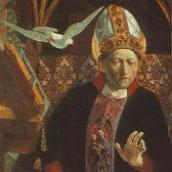These three days are marked off from the rest of Holy Week
not only by their special names but also by the rites and ceremonies associated
with them. These distinguishing marks commemorate the fact that during
this sacred three-day period our Lord was contented to be betrayed, and
given up into the hands of wicked men, and to suffer death upon the cross'
(Canadian BCP 1962, p. 174).
The liturgy so far this week has been devoted especially to the serial
reading of the passion narratives and the discourses of our Lord at the
Last Supper as recorded by St. John. We have seen how our Lord, having
loved his own who were in the world...loved them to the end' (John 13:1).
Moreover, we have heard how the Father and the Son will dwell with those
who love one another, as Jesus commanded them (John 14:23; 15:12).
In effect, we have been meditating on the breadth and length and height
and depth of the love of Christ which surpasses knowledge (compare Eph.
3:18, 19). His love must inevitably be the pole around which all
our considerations this week will cluster.
The very name Maundy Thursday' reflects this fact. The word maundy'
is taken from the Latin mandatum novum meaning new commandment'.
This was the new commandment of love delivered this day by Our Lord (John
13:34). In fact, the ancient ceremony of the foot-washing has been
revived in some parishes to emphasize this connection. (See John
13:14, 15). The Eucharist of the day celebrates the institution of
the sacrament of our Lord's Body and Blood
(1 Cor. 11:23).
In some parishes, after the Eucharist on Thursday evening, the altar
is stripped and left bare for Good Friday. This desolation of the
sanctuary, as appropriate as it really is, should not disguise the fact
that Good Friday was a good day for us, even the cause of all our good,
and ground of all our joy' (Sparrow). Nevertheless, we keep the day
as a major fast, remembering that our sins were the cause of his sufferings,
and that it was we that crowned his head with thorns, nailed his hands
and feet, and gored his side with a spear' (Sparrow). There are a
number of different ways of observing Good Friday liturgically. But
the passion according to St. John is always read, both because it is the
only account of the crucifixion that comes from an eye witness and because
it tends to show the cross as a means of glory (John 13:31). The
Eucharist should not be celebrated today, though in some parishes communion
from the reserved sacrament is offered.
Evensong on Good Friday commemorates our Lord's death and burial.
Easter Even commemorates our Lord's descent into hell, the place of departed
spirits. The ancient connection of Easter Even with Holy Baptism
is commemorated in the Collect and Epistle. In many parishes the
ancient Easter Vigil is being revived. At this service a special
candle is lighted, signifying the resurrection. Then a number of
Old Testament prophecies are read, foretelling our salvation through water
and the Spirit. Next the font is blessed and Holy Baptism is administered,
if there are any candidates. Then, the first Eucharist of Easter
is celebrated and at this Feast of the Resurrection we finally proclaim
He is risen indeed! Alleluia!'
